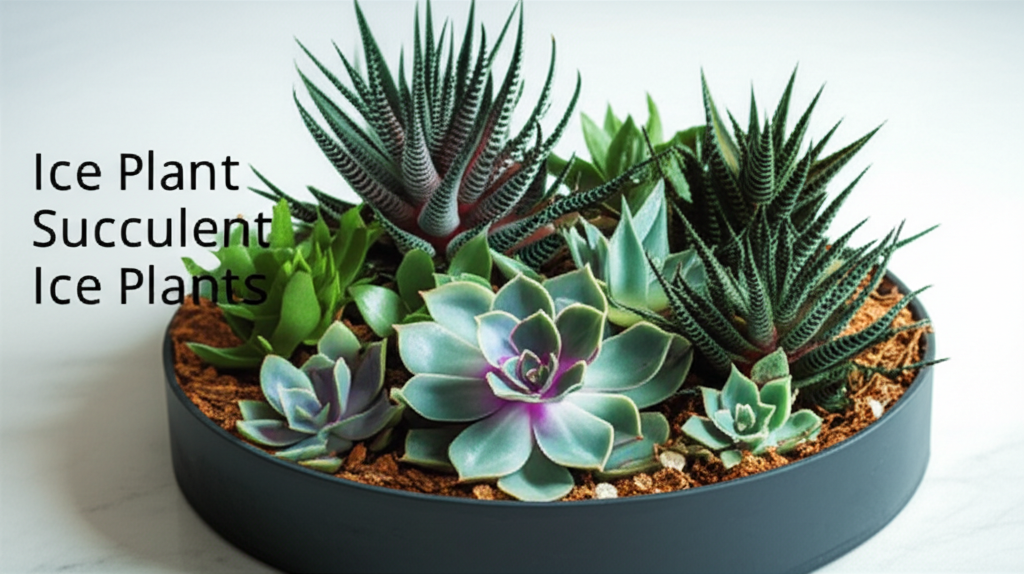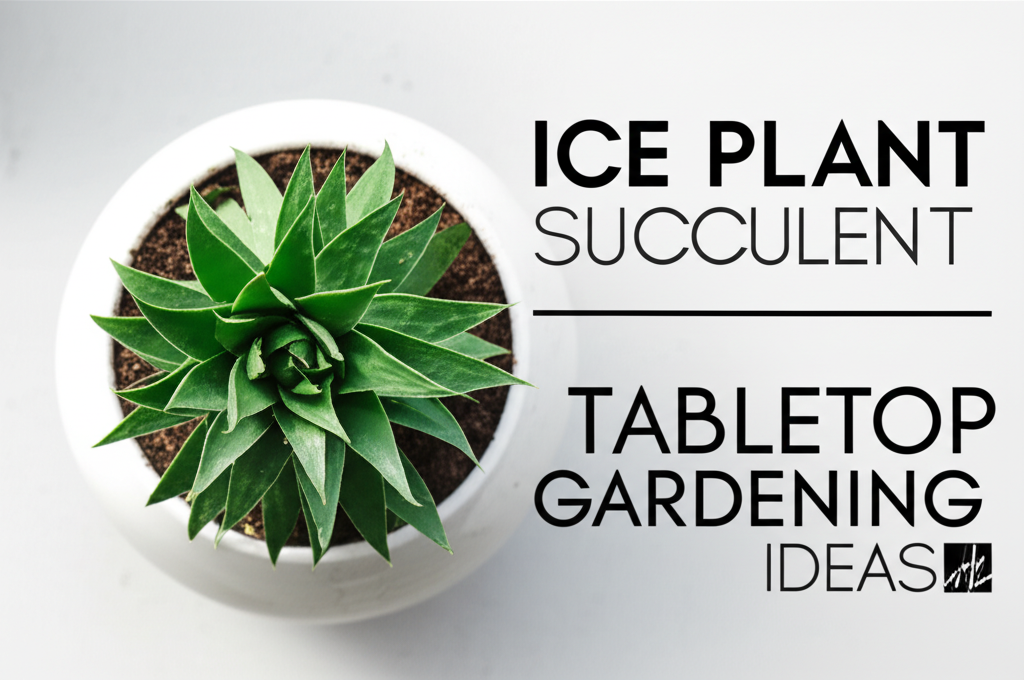The Allure of the Ice Plant Succulent
Ice plants, belonging to the Mesembryanthemaceae family, are a fascinating group of succulents celebrated for their unique, water-filled epidermal cells that give them a shimmering, almost “frosted” appearance. This characteristic, which earns them the name “ice plant,” not only provides a striking visual appeal but also serves a crucial purpose: reflecting excess sunlight and minimizing water loss in arid environments. These hardy and adaptable plants come in a dazzling array of forms, from sprawling groundcovers to upright varieties, and boast an impressive range of flower colors, making them ideal candidates for creative tabletop gardening. Their low-maintenance nature and compact size further enhance their suitability for indoor spaces, balconies, and small patios.
Why Choose Ice Plants for Tabletop Gardens?

The inherent qualities of ice plant succulents make them exceptionally well-suited for small-scale, decorative gardening. Their compact growth habit means they won’t quickly outgrow their containers, and their drought tolerance ensures they can withstand occasional neglect. Furthermore, the diversity within the ice plant family offers a wealth of design possibilities. You can mix and match different species for varied textures and colors, or focus on a single, show-stopping variety. The visual interest provided by their succulent leaves, coupled with their often vibrant blooms, transforms ordinary containers into miniature works of art, bringing a touch of nature and sophisticated design to any tabletop.
Key Ice Plant Succulent Varieties for Tabletop Gardens
When planning your ice plant tabletop garden, selecting the right varieties is key. Here are a few popular and visually appealing options:
- Delosperma Cooperi (Purple Ice Plant): Known for its vibrant magenta-purple flowers and trailing habit, making it excellent for cascading arrangements.
- Lampranthus (Daylight Ice Plant): Features an abundance of daisy-like flowers in shades of pink, orange, yellow, and red. They have a more upright, bushy growth.
- Pleiospilos Bolusii (Split Rock Plant): Mimics the appearance of smooth pebbles or stones, offering a unique, sculptural element to any arrangement.
- Conophytum (Pebble Plant): Tiny, clump-forming succulents that resemble small stones, perfect for miniature fairy gardens or very small containers.
- Lithops (Living Stones): Perhaps the most famous “stone” succulents, Lithops are fascinating for their uncanny resemblance to small pebbles and their unique flowering habits.
- Aptenia Cordifolia (Heartleaf Ice Plant): A vigorous trailer with heart-shaped leaves and small pink or red flowers, suitable for spilling over the edges of containers.
Creative Tabletop Gardening Ideas with Ice Plants
The beauty of ice plants lies in their adaptability to various design concepts. Here are some creative ideas to inspire your next tabletop gardening project:
1. The “Zen Rock Garden” Miniature
This design focuses on simplicity and tranquility, mimicking a larger Japanese rock garden on a smaller scale.
- Container: A shallow, wide ceramic or concrete pot with a minimalist design.
- Planting: Select a few varieties of Pleiospilos or Lithops, placing them strategically to resemble natural rock formations. Interspace them with small, smooth river stones and a layer of pale grey or white gravel for the “raked” effect. A single, small, upright ice plant like a Lampranthus can add a touch of height and color.
- Accents: Consider adding a tiny pagoda or a small piece of driftwood.
2. The “Cascading Jewel Box”
This concept emphasizes the trailing and flowering habits of ice plants to create a visually rich, overflowing display.
- Container: A hanging basket, a tiered planter, or a rustic terracotta pot with a good drainage hole.
- Planting: Combine trailing varieties like Delosperma Cooperi and Aptenia Cordifolia with some upright Lampranthus for contrast. Allow the trailing varieties to spill over the edges, creating a waterfall effect of leaves and blooms.
- Accents: Use decorative pebbles or small polished stones to fill any gaps between plants and add to the “jewel-like” quality.
3. The “Desert Oasis” Terrarium/Open Dish Garden
An open terrarium or a wide, shallow dish allows for the creation of a miniature desert landscape.
- Container: A clear glass bowl, a wide ceramic planter, or a repurposed apothecary jar (ensure it’s open for good air circulation).
- Planting: Layer the bottom with coarse gravel for drainage, followed by a well-draining succulent mix. Arrange various ice plant succulents, including some taller, architectural varieties alongside smaller, clumping types. Introduce small pieces of porous rock, sand, or decorative gravel for texture and visual appeal.
- Accents: Small pieces of driftwood, dried moss (used sparingly), and tiny desert-themed figurines can enhance the oasis feel.
4. The “Color Burst Fiesta”
This vibrant arrangement focuses on the stunning array of flower colors offered by many ice plant varieties.
- Container: A brightly colored ceramic pot or a simple white planter to let the flowers take center stage.
- Planting: Mix and match Lampranthus and Delosperma varieties with contrasting flower colors. Aim for a harmonious blend of pinks, oranges, yellows, and purples, ensuring a continuous bloom throughout the season.
- Accents: While the flowers are the main attraction, a few small, dark green or burgundy foliage succulents can provide a grounding contrast.
5. The “Sculptural Forms” Display
This approach highlights the unique shapes and textures of less common ice plants.
- Container: A simple, neutral-colored pot that doesn’t detract from the plants’ forms.
- Planting: Focus on varieties like Pleiospilos, Conophytum, and perhaps a uniquely shaped Mesembryanthemum. Arrange them with ample space between each plant to allow their individual sculptural qualities to be appreciated.
- Accents: Use large, interestingly shaped pebbles or stones as focal points, allowing them to interact with the forms of the succulents.
Essential Care for Tabletop Ice Plant Gardens
To ensure your ice plant tabletop gardens thrive, proper care is crucial. While they are low-maintenance, understanding their basic needs will prevent common problems.
Sunlight Requirements
Most ice plant succulents require ample sunlight to flourish and produce abundant blooms. Aim for at least 6 hours of direct sunlight per day. If grown indoors, a south-facing window is ideal. Insufficient light can lead to leggy growth and reduced flowering.
Watering Techniques
Overwatering is the most common mistake. Ice plants prefer to dry out completely between waterings.
- Frequency: Water thoroughly when the soil is dry to the touch. This might be every 1-3 weeks depending on the environment (temperature, humidity, light).
- Method: Water the soil directly, avoiding wetting the leaves, as this can encourage rot. Ensure excess water drains away freely.
Soil and Drainage
Excellent drainage is paramount for ice plant succulents. Use a specialized succulent or cactus potting mix. You can also create your own by mixing:
- 1 part potting soil
- 1 part perlite or pumice
- 1 part coarse sand
The container must have drainage holes.
Temperature and Ventilation
Ice plants generally prefer warm temperatures. They can tolerate heat well, but some varieties may benefit from partial shade during the hottest part of the day. They are typically not frost-tolerant. Good air circulation is also important to prevent fungal diseases.
Fertilizing
Ice plants are not heavy feeders. Fertilize sparingly during the growing season (spring and summer) with a diluted, balanced liquid fertilizer or a specific succulent fertilizer (diluted to half strength). Avoid fertilizing in fall and winter.
Troubleshooting Common Issues
Even with good care, you might encounter occasional problems.
- Leggy Growth: Usually a sign of insufficient light. Move the plant to a brighter location.
- Mushy Leaves/Rotting: Caused by overwatering and poor drainage. Allow the soil to dry out completely and ensure good air circulation. Remove any rotted parts.
- No Flowers: Can be due to insufficient sunlight, over-fertilizing, or the plant being too young.
- Pests: Mealybugs and spider mites can sometimes be an issue. Treat with insecticidal soap or neem oil.
Key Facts and Comparison of Ice Plant Succulent Gardening Styles
To help you choose the best approach for your tabletop garden, here’s a comparison of different styles:
| Gardening Style | Primary Visual Focus | Container Type | Key Plants Used | Maintenance Level | Ideal For |
|---|---|---|---|---|---|
| Zen Rock Garden | Simplicity, texture, natural forms | Shallow, wide, minimalist pot | Lithops, Pleiospilos, small upright succulents | Low | Tranquil spaces, minimalist decor |
| Cascading Jewel Box | Trailing foliage, abundant blooms | Hanging basket, tiered planter, overflowing pot | Delosperma, Aptenia, Lampranthus | Low to Medium (pruning may be needed) | Balconies, spaces needing visual softness |
| Desert Oasis | Miniature landscape, varied textures | Wide, shallow dish or open terrarium | Mixed ice plants, varied succulents | Low | Creating a contained scene, learning about succulents |
| Color Burst Fiesta | Vibrant floral display | Brightly colored or neutral pot | Lampranthus, Delosperma (various colors) | Low to Medium (deadheading may be beneficial) | Adding cheer and color to any space |
| Sculptural Forms | Unique plant shapes and textures | Simple, neutral pot | Pleiospilos, Conophytum, unique Mesembryanthemums | Low | Appreciating individual plant artistry |
Step-by-Step Guide to Creating Your Tabletop Ice Plant Garden
Here’s a general process for setting up your chosen ice plant garden:
- Choose Your Container: Select a container with drainage holes that suits your aesthetic and the plants you intend to use.
- Prepare the Drainage Layer: Add a layer of coarse gravel or broken pottery shards at the bottom of the container to ensure water can escape easily.
- Add the Potting Mix: Fill the container with your well-draining succulent mix, leaving enough space at the top for the plants.
- Arrange Your Plants: Before planting, arrange the ice plant succulents in the container to visualize the final design. Consider height, color, and texture. Place taller plants towards the back or center, and trailing varieties along the edges.
- Planting: Gently remove plants from their nursery pots, loosen any compacted roots, and place them in their designated spots. Fill in around the roots with more potting mix.
- Add Decorative Elements: Incorporate decorative stones, gravel, sand, or other accents to complete your desired look.
- Initial Watering: Water lightly after planting to help settle the soil.
- Placement: Place your finished tabletop garden in a location that receives adequate sunlight.
Pros and Cons of Tabletop Ice Plant Gardening
Here’s a balanced look at the advantages and disadvantages of creating these miniature gardens:
| Pros | Cons |
|---|---|
| Low maintenance and drought tolerant | Can be susceptible to overwatering if not managed carefully |
| Visually striking with unique textures and vibrant blooms | Requires specific well-draining soil |
| Compact size makes them ideal for small spaces | Most varieties need significant direct sunlight |
| Wide variety of species offers endless creative possibilities | Some varieties can be slow-growing, requiring patience |
| Adds a touch of nature and beauty to indoor or outdoor tablescapes | Can be prone to pests like mealybugs if conditions are not ideal |
| Educational and rewarding to watch them grow and bloom | Over-fertilizing can be detrimental |
Conclusion: Bringing the Sparkle Indoors
Ice plant succulents offer a unique and rewarding way to engage with gardening, even in the smallest of spaces. Their “frosted” appearance, coupled with their spectacular floral displays and diverse forms, makes them perfect for creative tabletop gardening. Whether you’re drawn to the tranquility of a miniature Zen garden, the vibrant chaos of a “Color Burst Fiesta,” or the sculptural beauty of living stones, there’s an ice plant arrangement waiting to bring a touch of sparkle and natural wonder to your home or office. With a little attention to their basic needs – bright light, excellent drainage, and careful watering – your tabletop ice plant garden will undoubtedly be a source of ongoing fascination and beauty.


